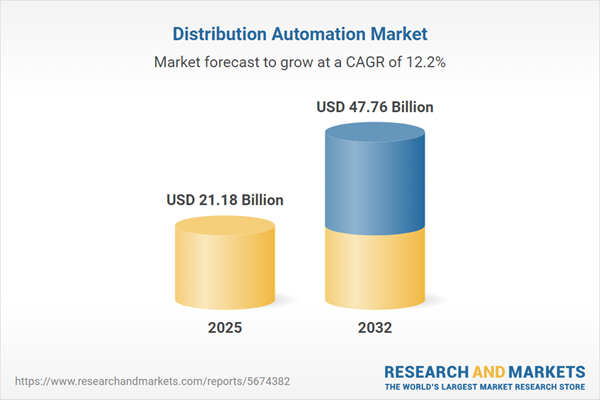Speak directly to the analyst to clarify any post sales queries you may have.
The Distribution Automation Market is rapidly transforming utility operations and resilience through digitalization, advanced analytics, and modular solutions. Strategic adoption of these technologies is redefining how grid infrastructures operate under evolving regulatory, supply, and technological forces, positioning senior leaders to drive performance and sustainability improvements across their organizations.
Market Snapshot: Distribution Automation Market Size and Growth Outlook
The Distribution Automation Market grew from USD 18.97 billion in 2024 to USD 21.18 billion in 2025. It is expected to continue expanding at a CAGR of 12.23%, reaching USD 47.76 billion by 2032. Robust growth is fueled by increasing investments in resilient grid management, digital transformation initiatives, and stricter regulatory requirements for reliability, cyber resilience, and sustainability in global power networks.
Scope & Segmentation of the Distribution Automation Market
- Component: Hardware, including communication networks, controllers and relays, sensors and meters; Services covering managed and professional implementations; Software comprising analytics and visualization tools, and distribution management systems (DMS).
- Utility Type: Private utility providers; Public utility providers.
- Distribution Network Type: Primary distribution; Secondary distribution channels.
- Application: Fault detection, isolation and restoration (FDIR); Load balancing and forecasting; Outage management and restoration protocols.
- End User: Industrial sector (manufacturing, mining, oil & gas); Residential customers; Utility sector entities.
- Regional Coverage: Americas (including United States, Canada, Mexico, Brazil, Argentina, Chile, Colombia, Peru); Europe, Middle East & Africa (United Kingdom, Germany, France, Russia, Italy, Spain, Netherlands, Sweden, Poland, Switzerland, UAE, Saudi Arabia, Qatar, Turkey, Israel, South Africa, Nigeria, Egypt, Kenya); Asia-Pacific (China, India, Japan, Australia, South Korea, Indonesia, Thailand, Malaysia, Singapore, Taiwan).
- Key Companies Analyzed: ABB Ltd., Cisco Systems Inc., Eaton Corporation PLC, ENMAX Corporation, Falcon Electric Inc., GE Vernova Group, Hitachi Ltd., Honeywell International Inc., Hubbell Incorporated, Rockwell Automation Inc., Schneider Electric SE, Siemens AG, Texas Instruments Incorporated, Toshiba Corporation, AgileMesh Inc., Automation Distribution Inc., Cummins Inc., G&W Electric Co., Kalki Communication Technologies Private Limited, Landis+Gyr AG, Xylem Inc., Ensto Oy, Schweitzer Engineering Laboratories, Itron Inc., S&C Electric Company.
Key Takeaways for Decision-Makers
- Distribution automation is central to modernizing grid performance, improving efficiency, and enabling cost savings by integrating advanced control and intelligence across utility networks.
- Digitalization, edge analytics, and IT-OT convergence enhance situational awareness and adaptability, enabling faster recovery from disruptions and improved energy resource integration.
- Regulatory shifts and standards are encouraging interoperability and cybersecurity measures, accelerating adoption of resilient, modular, and scalable solutions.
- Sophisticated segmentation by utility type, application, and network focus enables tailored deployment strategies that optimize investment impact for diverse stakeholders.
- Robust partnerships among vendors, service providers, and research institutions are driving continual innovation, allowing utilities to benefit from emerging capabilities such as digital twins, cloud-native analytics, and blockchain-based energy trading.
Tariff Impact: Navigating United States 2025 Measures
Recent US tariff measures have prompted utilities and suppliers to reassess procurement, sourcing, and technology deployment strategies. Many organizations are shifting toward local or regional suppliers, developing tariff-exempt product designs, and favoring modular or subscription-based models to limit exposure. These dynamics are influencing implementation timelines and promoting flexible service offerings attuned to cost efficiency and regulatory compliance.
Primary Keyword: Distribution Automation Market
Methodology & Data Sources
This report employs a rigorous approach integrating qualitative interviews with utility executives and providers, quantitative surveys on deployment trends, and extensive analysis of regulatory filings, industry databases, and patent activity. Subject-matter expert validation ensures actionable, accurate, and relevant insights for every segment under review.
Why This Report Matters
- Enables leaders to benchmark strategies against evolving regulatory, technology, and supply chain landscapes for informed capital planning.
- Offers actionable frameworks to navigate grid modernization, investment cycles, and risk mitigation in a shifting policy climate.
Conclusion
The Distribution Automation Market is at the forefront of power sector transformation. Stakeholders prepared to leverage emerging technologies and adaptable strategies are poised to achieve competitive advantage, unlock operational value, and ensure grid resilience for the future.
Additional Product Information:
- Purchase of this report includes 1 year online access with quarterly updates.
- This report can be updated on request. Please contact our Customer Experience team using the Ask a Question widget on our website.
Table of Contents
3. Executive Summary
4. Market Overview
7. Cumulative Impact of Artificial Intelligence 2025
List of Figures
Samples

LOADING...
Companies Mentioned
The key companies profiled in this Distribution Automation market report include:- ABB Ltd.
- Cisco Systems, Inc.
- Eaton Corporation PLC
- ENMAX Corporation
- Falcon Electric, Inc.
- GE Vernova Group
- Hitachi, Ltd.
- Honeywell International Inc.
- Hubbell Incorporated
- Rockwell Automation Inc.
- Schneider Electric SE
- Siemens AG
- Texas Instruments Incorporated
- Toshiba Corporation
- AgileMesh, Inc.
- Automation Distribution Inc.
- Cummins Inc.
- G&W Electric Co.
- Kalki Communication Technologies Private Limited
- Landis+Gyr AG
- Xylem Inc.
- Ensto Oy
- Schweitzer Engineering Laboratories
- Itron Inc.
- S&C Electric Company
Table Information
| Report Attribute | Details |
|---|---|
| No. of Pages | 195 |
| Published | October 2025 |
| Forecast Period | 2025 - 2032 |
| Estimated Market Value ( USD | $ 21.18 Billion |
| Forecasted Market Value ( USD | $ 47.76 Billion |
| Compound Annual Growth Rate | 12.2% |
| Regions Covered | Global |
| No. of Companies Mentioned | 26 |









